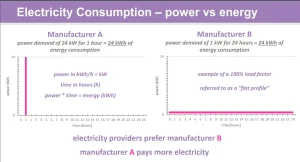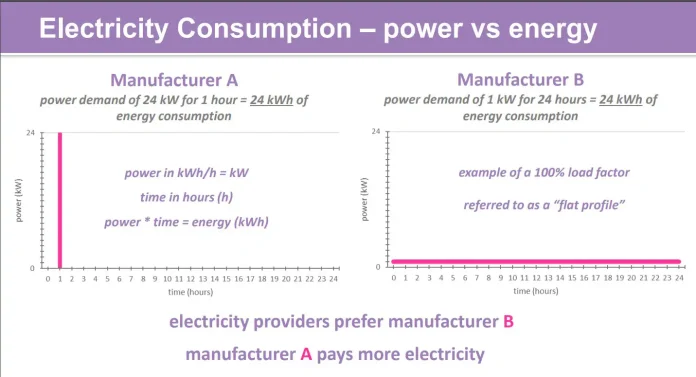By Cara Bommarito, sustainability manager, RadTech
RadTech’s fall meeting has wrapped up, and the attending members acquired great takesaways and conversations. One topic was the growing focus on energy conservation. Longtime RadTech member and current Board Member Jennifer Heathcote, vice president of business development at GEW (EC) Limited, presented a thought-provoking topic on energy and the global need for better energy efficiency. The presentation was a high-level overview of how energy and the grid deliver electricity to users. Users, in this case, represent about 87% of the world’s population. Heathcote’s presentation first started with a slide which, in essence, explained greenwashing. It is true many companies take liberties with their claims about sustainability. Heathcote cautioned attendees to be aware of “puffery” and claims that have little to no authenticity.
 The bulk of the presentation focused on the science and engineering that is our electrical grid. Heathcote broke down how electrical load is defined. “Load” refers to a component of a circuit that consumes electrical power. There are three major load types in the generation of electricity. Base load is the work horse that supplies a stable and constant source of energy 24/7, powered mainly by nuclear and coal sources. There is some supplement of geothermal and hydroelectric, but these are availability dependent. There current is a shift to natural gas occurring for this load type. Intermediate base load is used when base load demand is exceeded but is not yet at peak load conditions. This currently is sourced with natural gas and some wind and solar. Finally, attendees learned about peak load – a quick burst which turns on and shuts down quickly. This is implemented when usage is at its peak in the grid. A good example of this would be a hot summer afternoon when cooling is at its highest. Understanding the source energy of the electrical grid is important for the illustration of the next point.
The bulk of the presentation focused on the science and engineering that is our electrical grid. Heathcote broke down how electrical load is defined. “Load” refers to a component of a circuit that consumes electrical power. There are three major load types in the generation of electricity. Base load is the work horse that supplies a stable and constant source of energy 24/7, powered mainly by nuclear and coal sources. There is some supplement of geothermal and hydroelectric, but these are availability dependent. There current is a shift to natural gas occurring for this load type. Intermediate base load is used when base load demand is exceeded but is not yet at peak load conditions. This currently is sourced with natural gas and some wind and solar. Finally, attendees learned about peak load – a quick burst which turns on and shuts down quickly. This is implemented when usage is at its peak in the grid. A good example of this would be a hot summer afternoon when cooling is at its highest. Understanding the source energy of the electrical grid is important for the illustration of the next point.
The preferred manufacturing scenario – as well as the most affordable for businesses – is when “peak demand” is managed. When energy is consumed in shorter bursts, it places a huge demand on the grid and requires a lot of power to be supplied immediately. Energy providers prefer what is called a “flat profile” where, rather than 24 kW of power being consumed in one hour, 1 kW of power is consumed each hour over 24 hours. Image 1 provides a better understanding of this concept.
The presentation places an emphasis on the reality of what net zero can encompass. Heathcote mentioned that solar and wind are great sources of energy for intermediate peak load times. However, renewables are not well suited for the base load portion of the grid. Another issue with renewables is the battery technology. The battery technology is not where it needs to be to support real-world demand; however, battery technology can be useful during peak load times. Battery power can kick in to take down the load and save companies money because the rates for energy are higher at peak load times.
Heathcote mentioned other real-world examples of when net zero is failing in places in the global economy. Europe is facing a huge surge in prices of energy due, in part, to not having enough carbon sources of energy to support the base load. While net zero intentions are noble, they are not always practical for consistent energy needs.
Heathcote said this is the time for energy-curable technology to be considered as a vital solution for the approaching energy crisis. Conservation can make a huge difference in keeping people with power during this experimental phase in energy and net zero requirements. The benefits listed in Heathcote’s presentation are in reference to LED technology. UV LED reduces total installed power, reduces peak demand startup, reduces consumption during operation and reduces carbon footprint, even in net zero facilities. Energy-curable technology is an incredible sustainable solution with a reach to hundreds of applications in manufacturing, printing, food and so much more. The globe is running out of time and must look to alternatives.
What do you think the future looks like for energy demands? Can you share your successes in energy saving? Email cara@radtech.org to share how your experience with energy-curable technology has changed energy usage.






